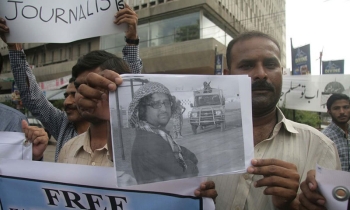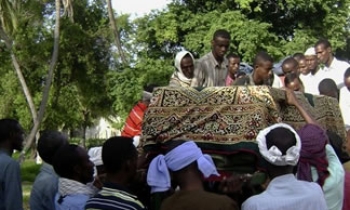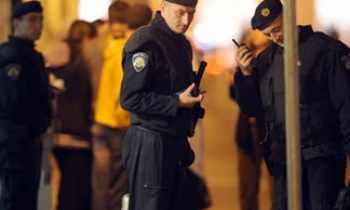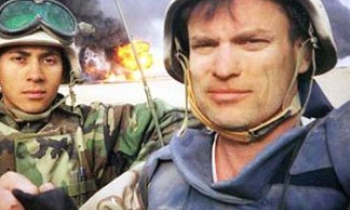 Tokyo -- Every year the Dutch-based non-profit organization World Press Photo sifts through thousands of news photographs from around the world in search of images that "represent an event, situation or issue of great journalistic importance and demonstrate an outstanding level of visual perception and creativity."
Tokyo -- Every year the Dutch-based non-profit organization World Press Photo sifts through thousands of news photographs from around the world in search of images that "represent an event, situation or issue of great journalistic importance and demonstrate an outstanding level of visual perception and creativity."
The resulting awards and accompanying exhibition have been running since 1955. This year's World Press Photo finalists were chosen from a record 69,190 submissions by 4,266 professional photographers from 123 countries. The 200 prizewinners will be seen by people in 80 cities.
Somewhat surprising and disappointing is the fact that not one of the pictures on display is from Japan, even though there is keen interest in the exhibition here. (World Press Photo is co-sponsored by Japanese camera-maker Canon and was installed last week at the Tokyo Museum of Photography in Ebisu.) The selection is somewhat Euro-centric, which is unsurprising as half of the jury are Europeans this year. There was but one representative from East Asia (Associated Press photographer Alberto Marquez of the Philippines). Hopefully this will change next year.
That said, the show provides a terrific ride through the top news stories of 2004. Not surprisingly, the earthquake-triggered tsunami which engulfed coastal regions of the Indian Ocean last December 26 is centerstage. Indian photographer Arko Datta's color photograph of a mourning woman in Tamil Nadu, India, was awarded first prize in the Spot News Singles category and took Photo of the Year honors for 2005. Also, a photo series on Indonesian victims of the tsunami earned the Spot News Stories category's First Prize for Australian photographer Dean Sewell.
These two photographers, working on opposite sides of the epicenter, offer opposing treatments of the same disaster. Sewell uses a wide-angle lens to record the incredible reach of the waves and extent of the damage. In Sewell's stark black-and-white pictures, the sea lies still in the background, in cold contrast to the wide swath of destruction it has wreaked.
From the other end of the emotional spectrum, Datta's single color photograph is of a woman dressed in a bright purple saree kneeling on the sand. Her palms are outstretched and she is wailing at the loss of a drowned relative, a man whose bloated, maggot-covered arm is visible to the elbow in the lower left of the frame.
In viewing the work of front-line photojournalists, I was reminded of a Joseph Stalin's macabre comment, that, "A single death is a tragedy, a million deaths is a statistic."
Looking at Datta's and many of the other pictures in this show, one begins to appreciate what Stalin meant. When we read a newspaper about a dozen killed in a fire, or of hundreds or thousands perishing in a flood, we register the numbers--then life goes on. The pictures here bring the wrenching reality home--for the individuals, the people that constitute these statistics, life does not go on.
I find most unsettling here the images of those about to die. Mexican photographer Daniel Aguilar, working in Haiti, snaps a suspected henchman of President Aristide's Fanmi Lavalas party. The picture was taken inside a car amid lynch mob paybacks visited on collaborators in aftermath of Aristide's flight from Haiti on February 29, 2004. An armed guard wearing a red beret guard casually sips a fruit juice as he pushes his heavy black boot against the face of the suspect. A crowd can be seen clamoring outside, and the attendant text informs us that shortly thereafter, the crowd gets the justice it is demanding by stoning and then burning the man alive.
There is an undeniable ability for news photographs to bring people to an awareness of unfamiliar or distant events. This is the power of the exhibition. Witness the Iranian asylum seeker in Holland who stitched his lips together in protest at the Dutch government's immigration policies, policies which are spelled out in the show's catalogue. Paul Vreeker's photo helped start a dialogue, and the man was allowed to stay in Holland.
The exhibition is divided into categories: General and Spot News, Contemporary Issues, Portraits, Sports Features and Action, Nature, Arts and Entertainment, Daily Life and People in the News.
This may seem like a bit of smorgasbord but not for those with a weak stomach. While there are a fair number of images which are positive or hopeful -- sports snapshots and festival dancers and so on -- most focus on human suffering. I feel compelled to advise parents that, while there are no age restrictions on admission, serious consideration ought to be given to the effects some of these images might have on the young. This provocative show represents reality to be sure. Be warned that it is hard-core reality.









